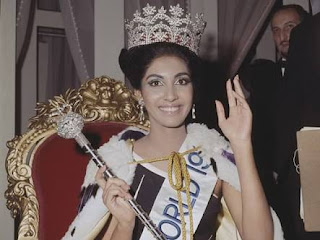Reita Faria was one of the best known Indians worldwide in her times. She is the the first Indian to wear the Miss World crown in 1966.
She is a qualified medical practitioner and now resides in Dublin, Ireland, with her husband Dr Colin Powell, whom she married in 1971. The couple has two daughters and five grandchildren.
Reita Faria Powel was born in 1945 in Mumbai. Reita grew up in Mumbai with her sister Philomena in a tight-knit Goan family that owned real estate and other businesses.
She is a qualified medical practitioner and now resides in Dublin, Ireland, with her husband Dr Colin Powell, whom she married in 1971. The couple has two daughters and five grandchildren.
Reita Faria Powel was born in 1945 in Mumbai. Reita grew up in Mumbai with her sister Philomena in a tight-knit Goan family that owned real estate and other businesses.
Early Days of Reita Faria
Born on 23rd August 1943, Reita Faria was born to Goan parents in Matunga. Although she is a Goan by birth, her childhood days were mostly spent in then Bombay. By above-mentioned ‘Miss World’ title, everyone easily assumes that she had a rich upbringing, but actually, she did not have any of these. Reita was born and brought up in a middle-class family of Mumbai where her father worked at a mineral factory, and her mother owned a salon in Marine Lines. She had a height of 5’8” and had an amazing sense of fashion, but Reita always wanted to become a doctor. And she did achieve that dream when she took admission at Grant Medical College of Mumbai after completing schooling.
Stepping a foot into the Glamour World
As said earlier that she had a great height according to Indian Standard, so she often attracted many modelling offers from different agencies. Convinced by so many praises and offers, she finally decided to try her luck when she was only 23 years old. She entered the ‘Miss Bombay’ contest organised by ‘Eve’s Weekly Magazine.’ For her, it was just a joke and more like an experiment. All she had to do was to send one photograph and done with it. And surprisingly she won the contest. After winning this ‘Miss Mumbai Crown’, Reita Faria also won the ‘Eve’s Weekly Magazine Miss India’ title as well. It was all like a daydream for her, but she never stopped and always took a step ahead.
Winning the Fame of ‘Miss World’ – Reita Faria Fought Against all the Odds
Back then, India’s beauty pageant industry was not very well-organised and when she was chosen as representative of ‘Miss World’, she did not have a passport. Also, she did not have a proper wardrobe for her ‘Miss World’ contest as well. After lots of hustle-bustle, she reached a chilly London with a suitcase full of borrowed clothes in 1966. And not to mention, she was a complete outsider there with a clear disadvantage in comparison to other European girls. But if you have the spark inside of you, can anyone stop you? Well, no. And no one could also stop Reita Faria, and she ended up winning the contest of ‘Miss World 1966’, making the history of the first face of Asia to win ‘Miss World’.
Days After ‘Miss World’
However, after completing one year tenure of ‘Miss World’, Reita returned to her old life again – being a doctor. She completed her MBBS degree and went to ‘King’s Medical College of London’ for higher studies. In 1971, she got married to David Powell. Eventually, she shifted to Dublin and started practising medical there. Currently, she is living there with her husband, two children and five grandchildren


Comments
Post a Comment